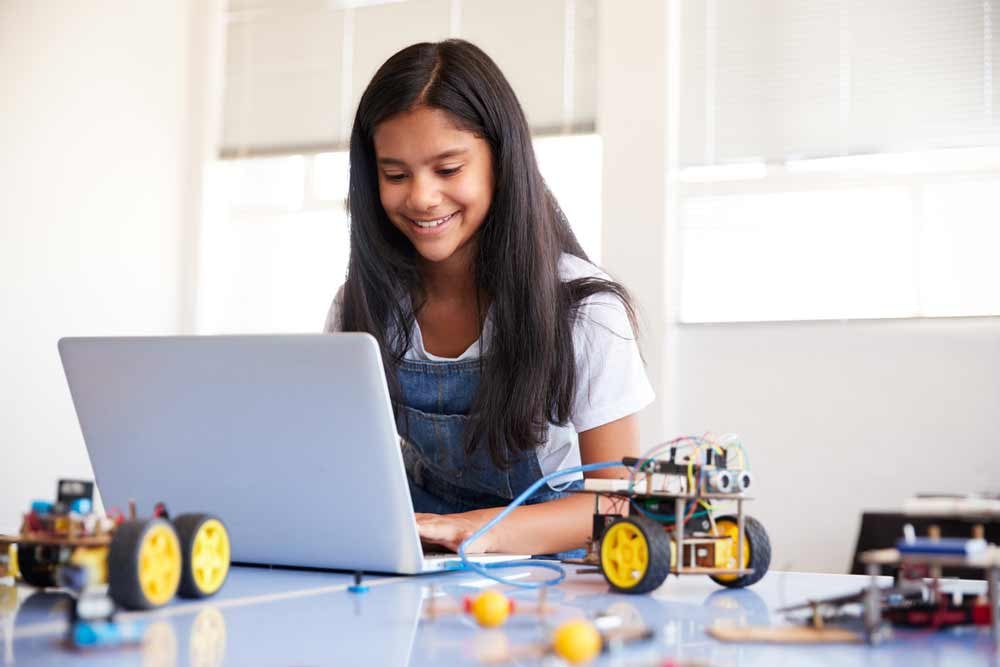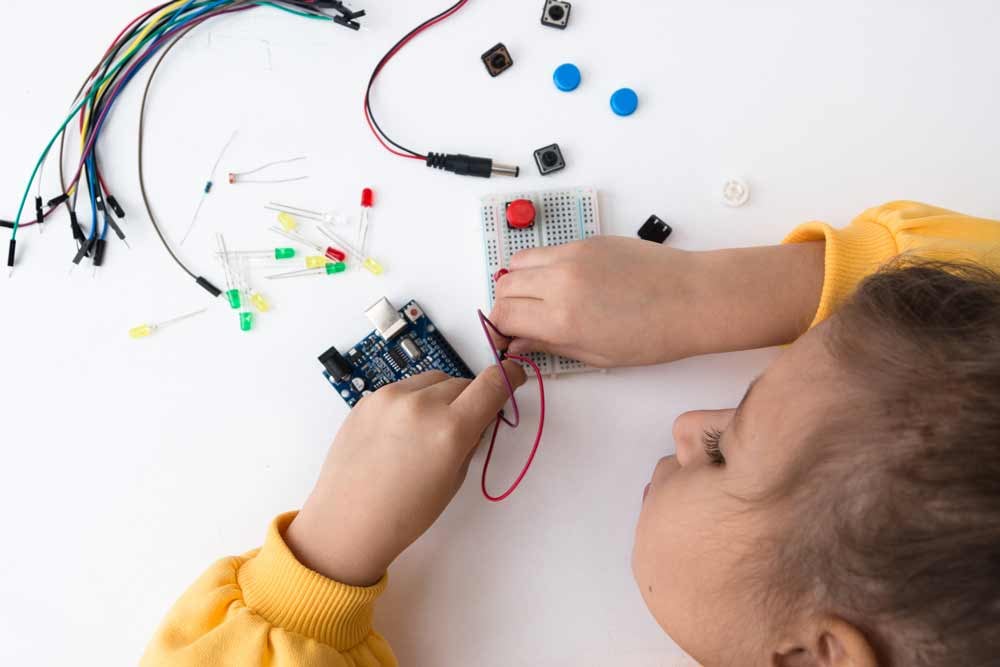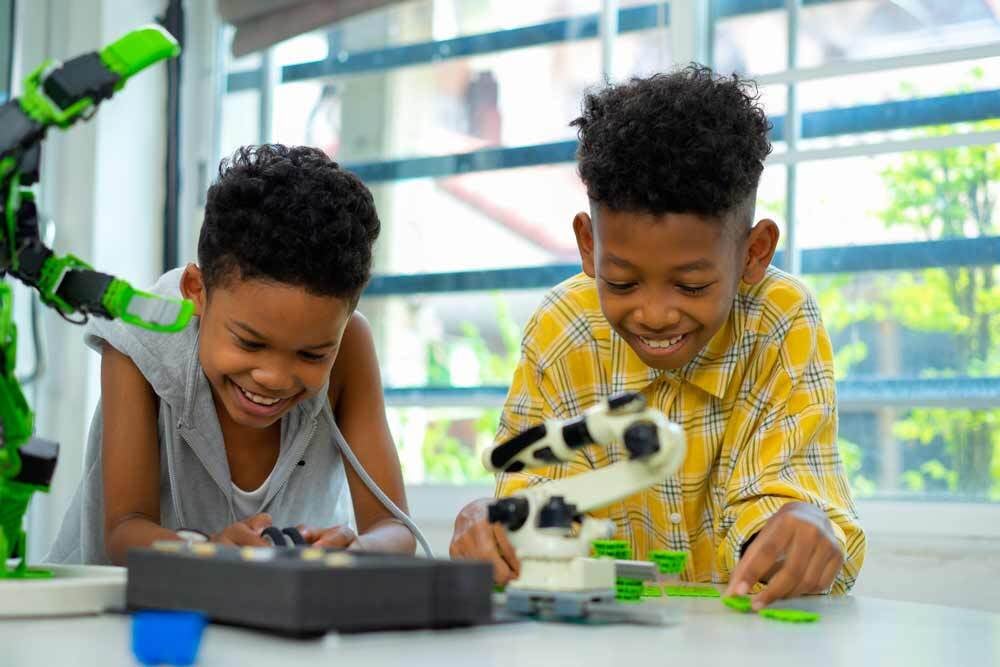
Robotics STEM Kits are a great way to engage students in hands-on and applied-learning activities. Here’s how to introduce Kid Spark’s Robotics STEM Lessons to Classrooms from 2nd Grade and Beyond
Robots have always been a fascination to young minds. From Elroy Jetson’s tinkering to translating R2-D2’s beeping dialects, that fascination has grown into modern innovations and world-changing technologies that now play a part in our daily lives. That technological shift does more than just introduce inventive products and modern solutions. Studies have estimated anywhere from 47% of jobs to be automated by 2033 which has a significant impact on the next generations of learners.
Bringing robotic STEM kits into the classroom is a great way to introduce these all-too-necessary fundamentals to our future STEM leaders. Having early access to STEM education, and robotics specifically, can set kids up for success in an ever-changing workplace and close the gap in professional STEM opportunities.
4 Awesome Benefits of Robotics STEM Kits
- Robotic STEM kits develop creative problem-solving skills
Have you ever designed and programmed a robot that can sense when objects are nearby? How about a movable bridge that can raise and lower with the touch of a button? These activities are just a few examples of what can be explored with Kid Spark Education’s robotic STEM labs for the classroom, and as you can imagine, children are required to apply their creative problem-solving skills as they learn.
Robotics incorporates multiple elements of STEM: science, technology, engineering, and mathematics. That’s why it’s such a powerful way to practice the STEM-based creative problem-solving skills that students can employ through multiple subjects of their educational career and throughout their lives.
By practicing approaching multiple problems through the scientific process and finding out-of-the-box solutions through experimentation, students grow their creativity and problem-solving through STEM lessons in robotics.
- Robotic STEM kits build resilience
Every level of robotic programming involves overcoming a problem by approaching it with different creative solutions. Through this process, students naturally learn to keep approaching challenges rather than shying away from them—a powerful skill of resilience that can be used for the rest of their lives.
A 2020 study in the International Journal of STEM Education revealed that students naturally engage in this trial-and-error loop through robotic STEM activities. Moreso, the hands-on and experimental learning available in Kid Spark’s STEM kits help foster this effect even more by supplying students with time to experiment on their own alongside the structured curriculum of core STEM concepts they’re learning. This is a delicate balance that has been carefully constructed through science-based curriculum design.
- Robotic STEM kits encourage team building and collaboration
Kid Spark’s classroom robotics kits are designed for small teams of two to four students. This group size helps engage shy students and students of different learning styles and helps build the social skills of team building and collaboration through exciting and fun activities.
Robotics is a naturally interactive field, so the lesson plans and activities included in Kid Spark’s curriculum are designed to bring students together to solve problems through collaboration. With careful guidance by teachers, groups of students can find innovative ways to solve problems by putting their minds together.
- Robotic STEM kits advance computational thinking
Computational thinking is a set of problem-solving skills that involve organizing tasks in a logical order and finding step-by-step solutions to fixing a problem. It’s the framework of programming and a valuable skill in and out of the world of robotics.
It’s no surprise the concepts of coding and robotics help develop students' computational thinking skills. In robotic STEM kits and activities like those included in Kid Spark’s STEM programs, these computational skills are advanced even further through regular practice and creative challenges.
At-Home Robotic STEM Kits vs. Classroom Robotics STEM Kits
Many different types of robotic STEM kits exist from single at-home activities to comprehensive programming across multiple grade levels. While most educators want to bring STEM into their classrooms, budget and curriculum criteria often leave the implementation of STEM programs to the educators themselves, limiting options for both teachers and students.

The most important factor to consider when bringing a robotics STEM kit to the classroom is its intended use. Many kits on the market are intended for at-home use, and while these might seem like a useful stop-gap solution for teachers, there are some significant differences between at-home and classroom robotics STEM kits.
Versatility and Reusability
At-home kits often focus on singular projects or single-use robots. These extracurricular activities are always helpful in supporting a diverse STEM ecosystem, but cannot provide the versatile solutions that classroom STEM kits offer.
Robotics STEM kits designed for the classroom often offer more versatility in learning opportunities with reusable components like Kid Spark’s STEM Pathways Labs. These comprehensive kits include robotic components that can be used for multiple lesson plans and can be custom-programmed by students. This experimental learning process helps students think more creatively, find their own solutions, and practice STEM concepts outside of rigid instruction or step-by-step directions like those you might find in an at-home robotics kit. With multiple solutions and activities, classroom robotics kits help students develop and practice their foundational STEM fluencies.
Progressive Learning
Kid Spark Education’s STEM labs are designed to support students through a cumulative journey of STEM education. By introducing them to core concepts as early as Pre-K, each lesson and lab kit adds to these foundational skills and builds upon them further, creating a cohesive and comprehensive curriculum that eliminates STEM education gaps or unchallenging repetition.
This feature is not only a unique element of Kid Spark’s STEM programs among other classroom curricula but also sets them further apart from at-home kits. At Kid Spark, robotics lessons are introduced upon a foundation of engineering, reasoning, and logical skills so that the concepts included in the robotics STEM kit are variations of familiar ideas. This aids in relational learning which provides a deeper understanding and retention of STEM concepts.
Adaptive Instruction
Not all students learn in the same way, and at Kid Spark, we’re passionate about eliminating any inequities in STEM education, including those for students who haven’t yet been exposed to STEM or who require adapted curriculum instruction for their learning style.
At-home robotics kits do not take these differences into account. There might be a robotics activity that is too simple for some of your students while being too challenging for others. While the activity itself may not be flawed, it takes mindful lesson planning to engage students of all levels.
That’s where a classroom robotics STEM kit like Kid Spark’s Pathway Lab comes in. With convergent and divergent learning embedded into the curriculum and small groups of 2-4 students, instruction can be adapted to engage all students while participating in the same activity.

What’s Included in Kid Spark’s Robotics STEM Kits?
From 2nd grade on, every STEM Pathways Lab covers multiple technologies and STEM concepts, including coding and robotics. These all-in-one STEM kits include everything you need to bring STEM into the classroom with a science-based curriculum, hands-on learning, and tools for educators. Here’s what’s included in each STEM Lab Kit:
- Engineering Components
For multiple lessons and activities, reusable engineering materials are provided in each STEM Pathways Lab, including building components, articulating components, and the robotics and electronic components necessary for the included robotics STEM lessons and activities.
- Robotics Controller
Each lab kit (serving teams of 2-4 students) includes a Micro:bit-based robotics controller, called the "Spark:bit". This controller can be used with various sensors, motors, and other Kid Spark engineering materials to create interactive robotic systems.
Students of varying abilities can use the Spark:bit Robotics Controller. Those without coding experience can start with simple drag-and-drop coding and work their way to custom text-based coding all using the same robotics controller and engineering components.
- Curriculum
Teachers are supplied with complete units of instruction that include unit overviews, interactive MakeCode programming tutorials, multiple hands-on lessons and challenges, and unit assessments. Physical workbooks and downloadable printables are also available.
Every lesson follows Kid Spark’s convergent to divergent learning format. Students start out learning new STEM concepts through step-by-step, guided instruction. All students explore the same content, build the same models, and arrive at the same solution. After students become familiar with a concept, they are challenged to apply what they have learned in creative and inventive ways.
- Professional Learning Tools
Kid Spark offers professional development modules and courses for educators to prepare the to use all program materials. These online learning courses help educators familiarize themselves with the program materials and resources they’ll be guiding their students through, along with helpful educator guides to aid in confident STEM instruction.
Get Started with Kid Spark Education
Are you looking for a comprehensive Robotics STEM Kit for your classroom? We’d love to connect you with a programs specialist and introduce you to Kid Spark’s STEM Programs. If you’re interested in bringing Kid Spark to your classroom, fill out this form, or contact us today!
.png?width=1270&height=453&name=Copy%20of%20Kid%20Spark%20Logo%20(Horizontal%20-%20Full%20Color).png)